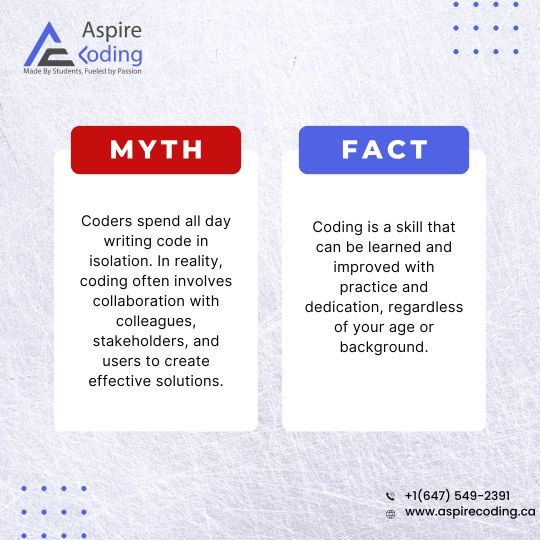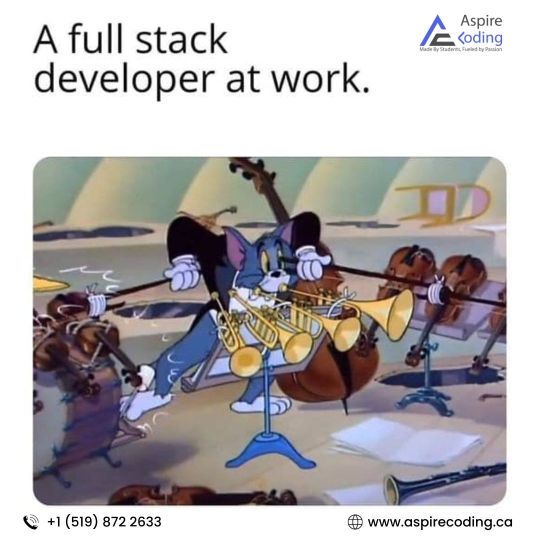#codingisfun
Explore tagged Tumblr posts
Text
Advent of Code - Day 24
Merry Christmas once more!
Today also wasn't easy, but at least I had time to finish before midnight, which is nice!
Part 1 was kinda cool. I had to refresh myself on some math, that took me a while, but once I figured out correct equation, implementing that wasn't that hard.
Second part gave me much more trouble. Thankfully - I had whole Christmas Eve dinner to think more about that.
...and while writing this sentence I got hit by weird feeling of deja vu, but I cannot explain why.
Anyway! I did look for some tips on the internet and managed to figure this out, though it's not really an elegant solution...

I really didn't expect to get to 48 stars. It's just one more day left!
#csharp#programming#coding#developer#codeblr#coder#advent of code#codingfun#codingisfun#challenge#.net#.net development#.net framework
5 notes
·
View notes
Text
𝐌𝐲𝐭𝐡: 𝐂𝐨𝐝𝐞𝐫𝐬 𝐬𝐩𝐞𝐧𝐝 𝐚𝐥𝐥 𝐝𝐚𝐲 𝐰𝐫𝐢𝐭𝐢𝐧𝐠 𝐜𝐨𝐝𝐞 𝐢𝐧 𝐢𝐬𝐨𝐥𝐚𝐭𝐢𝐨𝐧. 𝐈𝐧 𝐑𝐞𝐚𝐥𝐢𝐭𝐲, 𝐜𝐨𝐝𝐢𝐧𝐠 𝐨𝐟𝐭𝐞𝐧 𝐢𝐧𝐯𝐨𝐥𝐯𝐞𝐬 𝐜𝐨𝐥𝐥𝐚𝐛𝐨𝐫𝐚𝐭𝐢𝐨𝐧 𝐰𝐢𝐭𝐡 𝐜𝐨𝐥𝐥𝐞𝐚𝐠𝐮𝐞𝐬, 𝐬𝐭𝐚𝐤𝐞𝐡𝐨𝐥𝐝𝐞𝐫𝐬, 𝐚𝐧𝐝 𝐮𝐬𝐞𝐫𝐬 𝐭𝐨 𝐜𝐫𝐞𝐚𝐭𝐞 𝐞𝐟𝐟𝐞𝐜𝐭𝐢𝐯𝐞 𝐬𝐨𝐥𝐮𝐭𝐢𝐨𝐧𝐬.
Fact: Coding is a skill that can be learned and improved with practice and dedication, regardless of your age or background.

#coding#codinglife#codingisfun#codingbootcamp#codingmemes#creativecoding#codingforkids#codingdays#codingpics#htmlcoding#codingislife#codingproblems#codingchallenge#learncoding#codingclasses#kidscoding#livecoding#codingskills#codingcamp#factoftheday#mythfacts#facts
5 notes
·
View notes
Photo

Accordion Design HTML CSS & Bootstrap
Get Code from divinectorweb website
#accordion design#accordion#css accordion#bootstrap accordion#html css#bootstrap#learn to code#code#webdesign#divinector#divinectorweb#100daysofcode#codingdays#codingisfun#frontenddevelopment
2 notes
·
View notes
Text
Coding for Kids: It’s Never Too Early to Start

Introducing coding For kids at a young age can provide them with valuable skills that last a lifetime. It’s never too early to start coding children can learn basic programming concepts as early as preschool. Through interactive games and easy-to-use platforms like Scratch, kids develop problem-solving abilities and critical thinking that will help them in various aspects of life.
Starting coding early gives children an edge in today’s tech-centric world. They not only learn how to think logically, but they also gain a sense of creativity as they build their own games, animations, and websites. Coding fosters resilience, as kids often need to try different solutions to fix errors.
By embracing coding at a young age, children prepare themselves for future opportunities in STEM fields. With the right tools and guidance, coding can be both fun and educational, offering kids a solid foundation in technology and innovation for years to come.
#CodingForKids#EarlyCoding#LearnToCode#KidsProgramming#STEMEducation#TechSkillsForKids#CodingIsFun#FutureCoders#KidsInTech#StartCodingEarly
0 notes
Text
Application Programming Interfaces (APIs): Transforming the Digital Landscape

In today’s tech-driven world, digital connectivity and seamless communication between different software systems are essential. The behind-the-scenes magic that enables this smooth interaction is powered by Application Programming Interfaces (APIs). APIs have become the backbone of modern software development, revolutionizing how companies design, build, and scale their digital solutions. In India, where the digital transformation is in full swing, understanding APIs and their role is crucial for businesses, developers, and consumers alike.
What is an API?
An Application Programming Interface (API) is essentially a set of rules or protocols that allows different software applications to communicate with each other. Think of it as a bridge that connects two systems, enabling them to exchange data and functionalities. APIs are what allow your smartphone apps to interact with servers and databases, ensuring that when you request a service—be it booking a cab, ordering food, or checking your bank balance—the app can fetch the relevant information from a remote server in real time.
For example, when you use a payment gateway to make a purchase online, the gateway’s API enables your bank’s software to communicate with the merchant’s platform. This seamless integration is what makes digital transactions possible. APIs are at the core of many of the conveniences we enjoy today, whether it’s integrating social media with websites or enabling real-time data analytics.
The Evolution of APIs in India
Source-businesstoday.in
In India, where digital platforms are proliferating at an unprecedented pace, Application Programming Interfaces (APIs) have gained prominence across various sectors. Be it the banking industry, the e-commerce sector, or even government-led initiatives, APIs play a pivotal role in enhancing service delivery and improving user experience.
The Unified Payments Interface (UPI), developed by the National Payments Corporation of India (NPCI), is an excellent example of how APIs are transforming financial transactions. UPI’s API connects various banks and financial service providers, enabling seamless peer-to-peer and merchant transactions. This has drastically simplified payments in India and has contributed significantly to the government’s push toward a cashless economy.
Additionally, APIs are also driving India’s digital public infrastructure. The government’s DigiLocker initiative, which allows citizens to store and share official documents digitally, relies on APIs to enable secure and authenticated access across various departments and service providers.
Why are APIs Important?
The significance of Application Programming Interfaces (APIs) goes beyond just enabling software-to-software communication. APIs unlock new opportunities for businesses, developers, and users in several ways:
Efficiency and Automation: APIs allow businesses to automate tasks and improve operational efficiency. For instance, using APIs, e-commerce platforms can automate inventory management by connecting their system with suppliers’ databases. This means that stock levels are automatically updated, reducing human error and saving time.
Scalability: With APIs, companies can easily scale their services. For example, an e-commerce platform can integrate payment gateways, logistics solutions, and customer service tools via APIs, thus scaling its operations without building everything from scratch.
Customization and Flexibility: APIs provide the flexibility to customize services according to specific business needs. For instance, businesses can use different APIs to offer personalized recommendations to their users, improving customer experience.
Interoperability: In an era where multiple software systems are used to run business operations, APIs ensure that these systems can work together seamlessly. APIs provide the standardization needed for different applications to communicate with each other, making businesses more efficient.
Types of APIs
Image-by-arturmarciniecphotos
APIs come in different forms, each serving unique purposes depending on the requirements of the software system. Here are the most common types of APIs:
Open APIs (Public APIs): These APIs are available to developers and other users with minimal restrictions. They are meant to be used by external developers to enhance their applications. For example, Google Maps API allows developers to integrate location-based services into their apps.
Partner APIs: These are APIs that are shared with specific partners, usually under some form of licensing or business agreement. A company may share its API with a business partner to integrate services between their respective platforms.
Internal APIs (Private APIs): These are designed for use within an organization to improve internal processes. For example, a company may have an internal API that connects its customer management system with its sales platform to streamline business operations.
Composite APIs: These APIs allow developers to access multiple endpoints in one call. They are useful when a system requires data from various sources to perform a single task. For example, a travel booking site may use composite APIs to pull flight details, hotel availability, and car rental options all in one request.
The Role of APIs in the Indian Tech Ecosystem
In India, the tech ecosystem is evolving rapidly, and Application Programming Interfaces (APIs) have become the driving force behind many innovations. As more startups emerge and digital solutions are sought across industries, the demand for APIs is growing.
Fintech Sector: The Indian fintech ecosystem heavily relies on APIs for various services, from digital wallets to lending platforms. As mentioned earlier, UPI is one of the most prominent API-based solutions, revolutionizing digital payments across the country.
E-commerce and Retail: APIs have enabled e-commerce platforms to integrate various services like payment gateways, logistics, and customer support systems, making online shopping seamless and efficient for Indian consumers.
Healthcare: The integration of APIs in healthcare is transforming patient management, telemedicine, and digital health records. For instance, APIs allow telemedicine apps to securely share patient data with doctors and hospitals, improving the quality of care.
Government Initiatives: The Indian government’s push toward digitization is also powered by APIs. The Aadhaar authentication APIs, for example, enable various organizations to authenticate users’ identities securely. This has been particularly helpful in ensuring that benefits from government schemes reach the right individuals.
Challenges in API Implementation
Image-by-Dragos-Condrea-from-Getty-Images
While Application Programming Interfaces (APIs) offer numerous advantages, their implementation comes with its own set of challenges, especially in a diverse country like India:
Security Concerns: With APIs acting as a bridge between different systems, the risk of data breaches increases. It’s crucial to implement strong security measures like encryption and authentication to protect sensitive information.
Standardization Issues: India, with its vast and diverse tech landscape, faces challenges in standardizing APIs across industries. Different companies and organizations may use varying API protocols, making interoperability a complex issue.
Bandwidth and Infrastructure: Especially in rural areas, where internet connectivity is still catching up, APIs might not perform as efficiently. Ensuring smooth API functionality in regions with low bandwidth is an ongoing challenge.
The Future of APIs in India
As India continues its digital journey, Application Programming Interfaces (APIs) will undoubtedly play a crucial role in shaping the future. With the government’s focus on building a robust digital infrastructure and the rise of digital-first startups, APIs will remain at the heart of innovation.
In the future, we can expect APIs to evolve further, with enhanced security features, better standardization, and broader adoption across industries. As artificial intelligence (AI) and machine learning (ML) gain traction, APIs will also play a vital role in integrating these technologies into everyday applications, from smart cities to autonomous vehicles.
Conclusion
In summary, Application Programming Interfaces (APIs) have revolutionized the way software systems communicate and operate, both globally and in India. As businesses and industries continue to innovate, APIs will remain a critical tool in driving digital transformation. Understanding APIs and leveraging their potential can unlock new opportunities for growth and efficiency, making them indispensable in the Indian digital ecosystem.
#cybersecurity#datascience#development#engineering#hacker#softwaredevelopment#codingisfun#artificialintelligence#web#developers#ai#android
0 notes
Text

🎉 Day 1: The Journey Begins! 🎉
Alright, folks, buckle up because today marks the beginning of my epic quest to become a software wizard! 💻✨ I'm diving into #100DaysOfCode with Replit and Dr. Angela Yu's #100DaysOfPython challenge. 🐍 Expect lots of aha! moments, occasional syntax errors, and probably me crying over semicolons I forgot to add. 😂
But hey, every coding hero has to start somewhere, right? In 100 days, I might not be Tony Stark (yet), but I'll be creating some cool projects, one line of code at a time. 🚀 Let’s see where this wild ride takes me—fingers crossed, it involves less debugging and more celebrating. 🎉👩💻
Let’s go from hello world to world domination! 🖥️✨
Stay tuned for all the ups, downs, and everything in between. 🙌
#100DaysOfCode#100DaysOfPython#CodeNewbie#SoftwareDeveloperInTraining#CodingJourney#PythonLearner#DevLife#TumblrTech#DayOneDebugging#WatchMeGrow#LearnToCode#CodingIsFun#TechJourney#NerdGoals#StayTuned
0 notes
Text
Get ready to Code like a pro! Join Samyak Computer Classes. Contact us:- 9105106105 / 9772271081
1 note
·
View note
Text
A Comprehensive Guide for HTML CSS JavaScript Online Training

In today’s digital era, having a responsive website is not just a luxury; it’s a necessity. With the proliferation of devices with various screen sizes and resolutions, ensuring your website looks great and functions seamlessly across all platforms is paramount. If you’re ready to dive into the world of responsive web design while honing your skills in HTML, CSS, and JavaScript, you’re in the right place. Naresh IT’s HTML CSS JavaScript Online Training is here to guide you every step of the way.
Why Responsive Design Matters
Before we delve into the intricacies of creating a responsive website, let’s understand why it’s crucial for online success. In a world where users access the internet from smartphones, tablets, laptops, and desktops, a responsive website ensures a consistent user experience regardless of the device used. This not only enhances user satisfaction but also improves your site’s visibility and accessibility, ultimately boosting your online presence.
Getting Started with HTML, CSS, and JavaScript Online Training
Our comprehensive online training program covers everything you need to know to create stunning, responsive websites from scratch. Whether you’re a beginner or seasoned developer looking to enhance your skills, our expert instructors provide step-by-step guidance and hands-on exercises to ensure your success.
Key Topics Covered in Our Course:
HTML Fundamentals: Learn the building blocks of web development, including tags, attributes, and semantic markup. Dive into the latest HTML5 features and techniques to create well-structured and accessible web pages.
CSS Essentials: Master the art of styling your web pages with CSS. Explore selectors, properties, and values to customize the appearance of your site. Discover responsive design principles, such as media queries and flexible layouts, to adapt your content to different screen sizes.
JavaScript Basics: Elevate your web development skills with JavaScript. From manipulating the DOM to handling events and animations, our course covers everything you need to add interactivity and dynamism to your websites.
Building a Responsive Website: Step-by-Step Guide
Now that you have a solid understanding of HTML, CSS, and JavaScript, let’s embark on the journey of creating a responsive website. Follow these essential steps:
Planning Your Design: Start by defining your website’s goals, target audience, and key features. Sketch out wireframes and create a visual design mockup to guide your development process.
Mobile-First Approach: Embrace the mobile-first approach by designing your website for small screens first. This ensures a seamless experience for mobile users and simplifies the scaling process for larger devices.
Flexible Layouts with CSS Grid and Flexbox: Utilize CSS Grid and Flexbox to create flexible layouts that adapt to different screen sizes. These modern CSS techniques allow you to create complex grid structures and flexible containers with ease.
Media Queries for Responsive Styling: Implement media queries to apply different styles based on the device’s screen size and orientation. Adjust font sizes, margins, and padding to optimize readability and usability across devices.
Optimizing Images and Media: Ensure fast loading times and optimal performance by optimizing images and media assets for various devices. Use responsive images and video embeds to deliver the best viewing experience without compromising on quality.
Testing and Debugging: Thoroughly test your responsive website across different devices, browsers, and screen resolutions. Use browser developer tools and online testing platforms to identify and fix any layout or functionality issues.
Continuous Improvement: Responsive web design is an ongoing process. Monitor user feedback, analyze website analytics, and stay updated on the latest web development trends to continuously improve your site’s responsiveness and performance.
Take Your Skills to the Next Level with Naresh IT
Ready to embark on your journey to becoming a responsive web design expert? Enroll in Naresh IT’s HTML CSS JavaScript Online Training today and unlock your full potential. With our comprehensive curriculum, expert instructors, and hands-on projects, you’ll gain the skills and confidence to create stunning, responsive websites that stand out in today’s competitive online landscape.
youtube
Don’t miss out on this opportunity to elevate your career and make a lasting impact in the world of web development. Join Naresh IT’s growing community of learners and start your journey towards success today!
#javascript#programming#html#developer#webdevelopment#100daysofcode#html5#css3#javascriptdeveloper#codingisfun#javascripts#htmlcss#webdesign#codingpics#codingdays#Youtube
1 note
·
View note
Text

Time Master's Coding Classes For Kids teach coding basics, app/game development, and future skills with expert trainers. Enroll now!
Abu Dhabi: 052 2302277 Mussafah: 052 2302266
0 notes
Text
#programminglanguage#programmer#program#programming#programmingmemesandjokes#programmingmemes#programmingislife#programmingisfun#codingjoke#codinglife#codingisfun#coding#office#office memes#it memes#memes😂#memesdaily#memelife#funnymemes#funny
3 notes
·
View notes
Text
Coding Classes in Singapore: Unlock the secrets of programming and technology with dynamic coding classes offered in Singapore. From introductory coding concepts to advanced software development, our classes equip students with the knowledge and skills to excel in the digital age.
#singapore#coding#classes#codinglife#exploresingapore#visitsingapore#togelsingapore#singaporean#singapore🇸🇬#codingisfun#singaporeairlines#jastipsingapore#classess#codingclasses#singaporeblogger#singaporenails#singaporediscovers#singaporebaby#singaporecrystal#singaporecafe#codinghumor#.#Created by Inflact Hashtags Generator
0 notes
Text
Python Ternary Operator
Visit our site for free project source codes-- dailyaspirants.com . . Follow @dailyaspirants for more content on website development, programming languages like Python, PHP, SEO, Free tools..etc.
#pythonhub#pythonprogramming#python3#programming#pythonprojects#pythonbeginner#coding#chatgpt#AI#codingforkids#CodingisFun#codinglife#html#html5#css#Code#dailyaspirants#numpy
0 notes
Text
🚀 Unlock your web development potential with MMT's comprehensive course.
🌐 Dive into HTML, CSS, JavaScript, and more. Elevate your skills and boost your career. Limited slots available! Call now for details: 9644004360. 📞 Don't miss this opportunity to reshape your future in the digital world! 💻

#webdevelopment#MMTTraining#learntocode#code#programmers#coding#codinglife#codingbootcamp#codingisfun#codingmemes
0 notes
Text
Why Should Kids Learn to Code with GoGlobalWays

In today’s digital age, coding has become a crucial skill, and GoGlobalWays offers a dynamic platform for kids to dive into programming. Learning to code not only enhances problem-solving abilities but also fosters creativity and critical thinking. GoGlobalWays provides an engaging, child-friendly curriculum that makes complex concepts accessible and fun.
Their coding programs are designed to spark curiosity and build foundational skills through interactive projects and real-world applications. By coding with GoGlobalWays, children gain hands-on experience with the latest technologies, preparing them for future careers in tech.
Moreover, the platform’s emphasis on collaboration and experiential learning helps develop teamwork and communication skills, essential in today’s interconnected world. By starting early with GoGlobalWays, kids are not just learning to code; they’re building confidence and a solid foundation for lifelong learning and success in the digital landscape.
0 notes
Text
Advent of Code - Day 25 (Final)

Last one was tough, but I managed to resolve it in the end. Thankfully only one part today. I didn't go for too elegant solution. I implemented Karger alghoritm to find random cut and just repeat it until it removed provided amount of edges. But hey - it did give me a proper solution.

Overall - I'm really happy I pulled through this. I'll consider participating next year as well.
But I'll drop requirement I put on myself not to use 3rd party libraries. When I started this, I kind of expected the challenges to be much simpler (...I guess I didn't do a proper research before deciding), so I made it harder for myself. Which was really not necessary. So - next year I'll prepare a better base for it. Allow 3rd party libraries and consider selecting language more based on the task.
In the end - I had fun. Merry Christmas!
#csharp#programming#coding#developer#codeblr#coder#advent of code#codingfun#codingisfun#challenge#.net#.net development#.net framework
1 note
·
View note
Text
𝐉𝐮𝐠𝐠𝐥𝐢𝐧𝐠 𝐝𝐚𝐭𝐚𝐛𝐚𝐬𝐞𝐬, 𝐟𝐫𝐚𝐦𝐞𝐰𝐨𝐫𝐤𝐬, 𝐚𝐧𝐝 𝐔𝐈/𝐔𝐗 𝐢𝐧𝐭𝐫𝐢𝐜𝐚𝐜𝐢𝐞𝐬 - 𝐭𝐡𝐞 𝐝𝐚𝐢𝐥𝐲 𝐠𝐫𝐢𝐧𝐝 𝐨𝐟 𝐚 𝐜𝐨𝐦𝐦𝐢𝐭𝐭𝐞𝐝 𝐟𝐮𝐥𝐥 𝐬𝐭𝐚𝐜𝐤 𝐝𝐞𝐯𝐞𝐥𝐨𝐩𝐞𝐫.

#coding#codinglife#codingisfun#codingbootcamp#codingmemes#creativecoding#codingforkids#codingdays#codingpics#htmlcoding#codingjokes#codingislife#codingfun#codingproblems#codingchallenge#learncoding#codingclasses#kidscoding#livecoding#codingskills#codingcamp#codinginspiration
0 notes